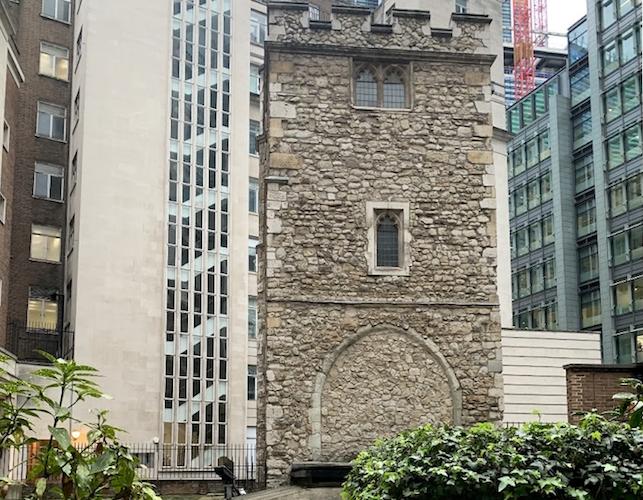Mark Lane in the City, near the Tower of London, has always been a bit of a puzzle to me. It sounds to me as if it was named after a bookmaker, but as historian John Stow pointed out in the late 16th century it was actually so called because of a “mart” or cattle market once located there. If you walk down it today, starting from the Great Tower Street end, it seems to offer only a conglomeration of overcrowded office blocks.
However, a couple of its newish buildings bear the name Corn Exchange – a reminder that an actual Corn Exchange existed in the area from 1747 for nearly 250 years, selling oats, beans and grain on behalf of farmers. From 1826 it had rival, also on Mark Lane, and between them they generated so much chaff it is easy to see why a street running parallel to Mark Lane, which bore the brunt of it, was called Seething Lane – “seething” means constantly agitated. Continue along Mark Lane and find a surprise on the left hand side: a Grade I listed church tower with no church attached.
It is what remains of a church called All Hallows Staining, an earlier version of which was recorded on the site in the late 12th century. All Hallows means “all saints” and “staining” means stone, which distinguished it from other All Hallows churches in the City, which were made of wood. It is situated next to its benefactor, the Worshipful Company of Clothworkers, one of the City’s livery companies. This helps explain the tower’s Grade I status.

Beneath the tower and slightly to one side of it there is crypt (shown in the engraving above). But the crypt wasn’t part of All Hallows Staining church. It was originally situated in Monkwell Street, which ran through where the Barbican estate now stands, and formed part of an ancient hermitage known as the Chapel of Saint James in the Wall, the wall being London Wall.
Following King Henry VIII’s dissolution of the monasteries in 1543, the chapel was given to local man, William Lambe, who is best known for, in 1577, building a conduit to carry water over 2000 yards from near the junction of what is now Lambs Conduit Street – named after Lambe – and Long Yard in Bloomsbury to a conduit head at Snow Hill in Holborn.
This brought fresh spring water to the inhabitants of Holborn long before the New River company started supplying it almost 40 years later. Lambe was also a longstanding member of the Clothworkers company, and when the chapel was pulled down in 1872 its crypt was moved, stone by stone, to All Hallows Staining. Every year, the adjoining Clothmakers’ Hall hosts a service to commemorate Lambe, who has been described as “a person wholly composed of goodness and bounty”.

There are plans for a major redevelopment scheme which envisage incorporating the tower and crypt as the focal point of a new public open space, which would bring a largely lost part of the City to renewed prominence. It may come as a surprise to City commuters that there was once a Mark Lane London Underground station. It was actually on Seething Lane, but not named after it because it didn’t sound soothing enough for a station.
You can still see the former entrance to it in Byward Street (above, left) and if you peer through the gate the top of the stairs leading down to the platform is visible. You can also, apparently, still see one of the Mark Lane platforms during the Tube ride from Monument to Tower Hill, but the train I took for that journey was travelling too fast for me to spot it or photograph it. Unless you happen to be a Tube driver, it remains a lost bit of London.
This is the seventh article in a series of 20 by Vic Keegan about locations of historical interest in the Eastern City part of the City of London, kindly supported by the EC BID, which serves that area. On London’s policy on “supported content” can be read here.


Interesting enough but I have two letters to Western? Holy Brothers, 26 Mark Lane, City London, postmarked Dundee Sept 1857. (penny red stamp)
The reverse has a crown stamp, with H (crown) V (within a circle), wonder if it was to do with that church-as it was-!?
AS Matter of interest to you & who ever.
WAS Dundee the post office for mail from
‘Balmoral’?, during this era..